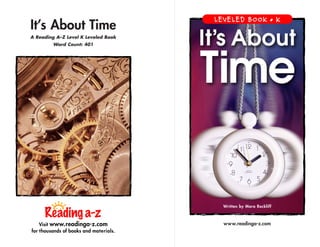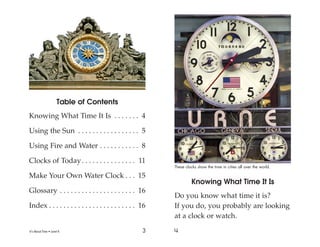Itsabout time
- 1. Itâs About Time A Reading AâZ Level KâLeveled Book Word Count: 401 Visit www.readinga-z.com for thousands of books and materials. www.readinga-z.com LEVELED READER âĒ ALEVELED BOOK âĒ K Written by Mara Rockliff
- 2. www.readinga-z.com Itâs About Time Level K Leveled Book ÂĐ Learning AâZ Written by Mara Rockliff All rights reserved. www.readinga-z.com Photo Credits: Front cover, back cover, title page, pages 3, 7 (left, top right), 11 (left, center right, right), 12 (main), 13 (main, inset), 14 (center left, center, center right, top right, bottom left, inset): ÂĐ Jupiterimages Corporation; page 4: ÂĐ Michelle Bennett/Lonely Planet Images; pages 5, 6: ÂĐ Learning AâZ; pages 7 (bottom right), 14 (top left, top right, center right): ÂĐ ArtToday; page 8: ÂĐ David R. Frazier Photolibrary, Inc./Science Photo Library/Photo Researchers, Inc.; pages 9, 11 (center left), 12 (inset), 14 (bottom right), 15: Craig Frederick/ÂĐ Learning AâZ Written by Mara Rockliff Correlation LEVEL K J 17 18 Fountas & Pinnell Reading Recovery DRA
- 3. Itâs About Time âĒ Level K 3 4 Table of Contents Knowing What Time It Is . . . . . . . 4 Using the Sun . . . . . . . . . . . . . . . . . 5 Using Fire and Water . . . . . . . . . . . 8 Clocks of Today . . . . . . . . . . . . . . . 11 Make Your Own Water Clock . . 15 Glossary . . . . . . . . . . . . . . . . . . . . . 16 Index . . . . . . . . . . . . . . . . . . . . . . . 16 Knowing What Time It Is Do you know what time it is? If you do, you probably are looking at a clock or watch. These clocks show the time in cities all over the world.
- 4. Itâs About Time âĒ Level K 5 6 Using the Sun Long ago, people didnât have clocks or watches like you do. When the sun rose, they got up, and when the sun went down, they went to bed. They told time by the position of the sun in the sky. People discovered that they could use a stick and the sun to tell time. This was called a shadow clock. They put a stick in the ground, pointing straight up. The direction of the stickâs shadow and how long or short it was told them the time. Shadow clocks made it easier to tell time between sunup, noon, and sundown. morning noon evening The sun tells when it is morning, noon, and evening. morning sun SUN evening sun SUN noon sun SUN
- 5. Itâs About Time âĒ Level K 7 8 A better kind of shadow clock was called a sundial. Sundials had a pointer and a base. The pointer cast a shadow on marks around the base. People could tell time by reading the marks. But shadow clocks were not good for telling time on cloudy daysâor at night. Using Fire and Water One kind of clock that didnât need the sun was a water clock. A water clock was a container with a tiny hole in the bottom. Water would steadily drip out of the hole. Marks on the inside of the container showed the time. It took one hour for the water to go down one mark. A modern water clockSundials made telling time using shadows more accurate.
- 6. Itâs About Time âĒ Level K 9 10 Another kind of clock that didnât need the sun was a candle clock. You would know the time by how much of the candle had melted. The candle had marks down its side to show the hours. Sometimes people used candle clocks as alarm clocks. They put a nail in the candle at the time they wanted to wake up, hanging a shoe on the nail. When the candle melted down, the nail fell out and the shoe hit the floor with a BANG! Candle clocks were used to tell time after the sun went down.
- 7. Itâs About Time âĒ Level K 11 12 Clocks of Today Now there are all kinds of timepieces, from tall grandfather clocks to watches we wear on our wrists. Most clocks run on electricity from batteries. Many clocks have two hands that point to numbers in a circle on the clock face. These are called analog clocks. Other clocks donât have hands, only numbers. These are called digital clocks. Big Ben, an analog clock tower in London, England grandfather clock digital watch pocket watch analog watch A digital clock
- 8. Itâs About Time âĒ Level K 13 14 There are many more types of clocks, too. Clocks hang in and on buildings. Clocks adorn wrists and mantles. Clocks are everywhere! Inside one kind of analog clock is a carved bird called a cuckoo. Every hour, the door opens and the bird pops out and sings its song: cuckoo, cuckoo, cuckoo! At noon, a cuckoo clock cuckoos 12 times.
- 9. Itâs About Time âĒ Level K 15 16 Glossary analog (adj.) using hands and dials to show time on a clock (p. 12) candle burning candle marked with clock (n.) the hours (p. 9) cuckoo (n.) carved bird used in a cuckoo clock (p. 13) digital (adj.) using a row of numbers, rather than hands on a dial (p. 12) electricity (n.) power source for clocks and watches (p. 11) grandfather tall, fancy clocks that chime clocks (n.) with the time (p. 11) shadow clock that uses an objectâs clock (n.) shadow to tell time (p. 6) sundial (n.) more complex shadow clock that uses the sun to tell time (p. 7) water clock (n.) bowl that drips water to tell time (p. 8) Index alarm clock,â 10 batteries,â 11 Big Ben,â 12 candle,â 9, 10 hands,â 12 shadow,â 6, 7 sun,â 5, 6 water,â 8, 15 Make a Water Clock Try This âĒ a partner âĒ a large plastic bottle with the top cut off âĒ two paper cups âĒ a clock with a second hand âĒ a pin or tack, masking tape, and water 1 Stick a piece of masking tape along the outside of the bottle, from top to bottom. 2 Poke a small hole with a pin or tack in the bottom center of one cup. Fit the cup snugly into the top of the bottle. 3 Have your partner use the other cup to pour water into the cup with the hole while you start timing right away. Keep the water clockâs cup about halfway full. 4 Every 30 seconds, mark the water level on the tape. You will need:








